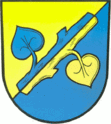Hnojník
| Hnojník | ||||
|---|---|---|---|---|
|
||||
| Basic data | ||||
| State : |
|
|||
| Region : | Moravskoslezský kraj | |||
| District : | Frýdek-Místek | |||
| Area : | 641 ha | |||
| Geographic location : | 49 ° 41 ' N , 18 ° 32' E | |||
| Height: | 365 m nm | |||
| Residents : | 1,454 (Jan 1, 2019) | |||
| Postal code : | 739 53 | |||
| License plate : | T | |||
| traffic | ||||
| Street: | Třinec - Horní Tošanovice | |||
| Railway connection: |
Český Těšín– Frýdek-Místek |
|||
| structure | ||||
| Status: | local community | |||
| Districts: | 1 | |||
| administration | ||||
| Mayor : | Dagmar Molinová (as of 2008) | |||
| Address: | Hnojník 222 739 53 Hnojník |
|||
| Municipality number: | 598160 | |||
| Website : | www.hnojnik.cz | |||
Hnojník (Polish Gnojnik , German Hnojnik or Hnoinik , Gnoynik ) is a municipality in the Czech Republic . It is located nine kilometers southwest of Český Těšín and belongs to the Okres Frýdek-Místek .
geography
Hnojník is on the right side of the Stonávka in the Beskid foothills. State road 68 and the railway line Český Těšín – Frýdek-Místek run through the village . The expressway R 48 / E 462 passes to the east.
Neighboring towns are Třanovice , Hůrka and Běrnoutí in the north, Vělopolí in the northeast, Střítež in the east, Smilovice in the southeast, Poruby and Komorní Lhotka in the south, Hlíniky, Dobratice , Lesní Dvůr and Poloniny and Poloniny in the southwest, Vyrubanéjice and Horní Tošalovec in the west in the north-west.
history
Hnojník was probably established as a Slavic settlement at the end of the 12th century. The first written mention of the village took place in 1305 in the tithe register of the diocese of Wroclaw . From 1445 the free rule Hnojník was the seat of the noble family of Stašek von Hnojník. In 1483 the dukes of Teschen acquired the rule, which they sold to the Pelhřim von Třankovice ( Pelchrzim von Trzankowitz) at the beginning of the 16th century . After them the Tluck von Toschonowitz and the Marklowsky von Žebrák followed as owners. In 1736 the Bees-Chrostin family acquired the Hnojnik estate. At that time, the Hnojnik estates also included the villages of Rakovec, Nebory, Dolní Lištná and Lyžbice, including a part of Smilovice, on the Ropičanka and Olsa rivers . The Counts of Bees-Chrostin kept expanding their property. Until the beginning of the 19th century, Horní Tošanovice , Ráj, Darkov, Louky nad Olší and Konská were attached to the rule.
After the abolition of patrimonial Hnojnik formed a community in the Teschen district from 1850. The railway from Teschen to Friedeck , inaugurated in 1888, connected the village to the railway network. After the collapse of the Austro-Hungarian monarchy and the loss of their offices in the Teschen district, the Bees-Chrostin family moved their headquarters from Hnojnik to Vienna . From then on, Hnojnik Castle only served as a summer residence. From 1920 the place belonged to the Český Těšín district. In 1938 Gnojnik came to Poland as part of the Olsa region . In 1930 Tomáš Garrigue Masaryk stayed with his former fellow student Johann Nepomuk Beess-Chrostin at Hnojnik Castle. From 1939 to 1945 Hnoinik belonged to the Teschen district and came back to Czechoslovakia after the end of the war. In 1945 the goods of Count Bees-Chrostin were confiscated by the Okresní národní výbor Český Těšín (ONV, German District National Committee). After the dissolution of the Okres Český Těšín, the community was assigned to the Okres Frýdek-Místek in 1961. Until 1966 u. a. the local national committee (MNV) and a state forest enterprise housed. It was then sold to the Hnojník state estate as the headquarters and residence of the management. The hall on the first floor was used for weddings. In 1980 the large municipality of Hnojník was formed, into which all of the surrounding towns were incorporated. After the Velvet Revolution, the villages broke up again and formed their own communities. A Polish minority lives in Ropice, to which almost 9% of the population belong (2001).
Community structure
No districts are designated for the municipality of Hnojník. The settlements Kozačinec and Rakovec belong to Ropice.
Attractions
- Hnojník Castle, built in the 18th century by Joseph Kornhäusel as a Baroque castle, was rebuilt in Empire style around 1850. Since the privatization in the 1990s, the castle has not been used and is in ruins.
- Family grave of the Beess-Chrostin family in Empire style
- Parish church of the Assumption of Mary, built 1808–1812 by Florian Ilg
- Statue of St. John of Nepomuk
Sons and daughters of the church
- Adam Makowicz (* 1940), Polish jazz pianist
Web links
Individual evidence
- ↑ Český statistický úřad - The population of the Czech municipalities as of January 1, 2019 (PDF; 7.4 MiB)
- ↑ Hošák, Ladislav - Šrámek, Rudolf: Místní jména na Moravě a ve Slezsku I-II. Prague


